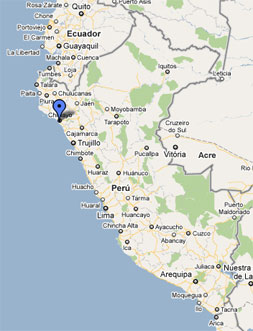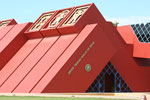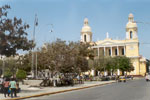About Chiclayo City
The Chiclayo is a part of Peru where the tropical sun, desert oases and the fresh sea breeze come together. Legend has it that the god Naylamp sailed here together with a vast retinue thousands of years ago to found his empire. In fact, many ancient civilizations saw the strategic advantage of controlling this region, which today is a major business hub in northern Peru, where routes come together from the coast, highlands and jungle.
On top of the desert sands and in the midst of valleys, ancient civilizations constructed sacred pyramids. But it was not until 1987, the year of the discovery of the Lord of Sipán (the most grandiose tomb in the Americas) that the world took notice of the importance of these temple mounds, fallen from grace on the outside but hiding splendor in the inside: Sicán , Túcume and Chotuna to name a few. As a result of the recovery, world class museums, the best in Peru, like the Royal Tombs of Sipán Museum , have been built.
Chiclayo City is the capital of the department of Lambayeque. Is a skilful and economical power city from the north of the country. Located on a productive valley, where agriculture activities are very important, outstanding rice production, sugar cane and cotton. It is a strategic point in the middle of many highways and roads connections.
In its valleys flourished many important pre-Inca cultures, such as "Lambayeque or Sicán", "Mochica" and "Chimú". During the Colony, it was only a simple Indian village in the road that connected Lambayeque and Zaña. Colony constructions does not exist, nevertheless today it is a city in full development process, having important discoveries as a main entrance, such as "El Señor de Sipán" (Lord of Sipán) at Huaca Rajada (important master discovered in 1987 with his in-life treasures), "Señor de Sicán" at Batangrande - Pómac and Túcume. Thanks to these important discoveries, Chiclayo turns out to be the second important destiny, after Cuzco, for the archaeological and monumental tourism in Peru.
The kindness and warmness of the people from Lambayeque had worth the nickname of "capital of friendship"; being very religious and having devotion to "Cruz de Chalpón", that each year celebrate a great festival that joins a lot of pilgrims in Motupe from all the country.
Chiclayo City Overview
-
Location:
North coast, 95 feet above sea level
(29 m.) -
Distances to Chiclayo:
-
Population:
757,500 inhabitants
Chiclayo Guide
Archaeological Sites in Chiclayo : There are hundreds of archaeological places located in the valleys of Zaña, Lambayeque, La Leche and Motupe, where the pre-Inca cultures Lambayeque, Sicán, Mochica and Chimú, developed until the arrival of the Incas. In these valleys jewels of gold had been found and extracted, forming the fabulous collection appreciated in local museums. Outstanding the last discoveries of "Señor de Sipán" (Lord of Sipan) in Huaca Rajada, "Señor de Sicán" in Batangrande - Pómac, and the Valley of he Pyramids in Túcume.
Museo Tumbas Reales de Sipán : The Museum of the Royal Tombs of Sipán showcase the marvelous finds from Huaca Rajada. Exhibits the most important archaeological remains of the Mochica Culture, in an exceptional exhibition that combines maximum scientific accuracy, security and enjoyment to show the jewels, emblems and ornaments found in the tomb of a Mochica government leader called the Lord of Sipán. Located in Lambayeque city.
Museo Nacional Sicán : This unique museum is the result of over two decades of scientific investigation by the Sicán Archaeological Project. The museum is singular in a number of respects: It is dedicated to scientific research of the Sicán or Lambayeque culture and dissemination of its results, as well as protection and storage of the material remains of this culture. This exhibit focuses on all aspects of the Sicán people and their culture. Located in Ferreñafe city.
Brüning Museum: Here, a collection of archeological objects gathered by the German ethnographer Heinrich Brüning is displayed. The four floors of the museum show ceramic, textile, stone and wood worked artifacts. Taken together, they demonstrate the vigorous artistic and technological character of the regional cultures of the past 5000 years. The "Sala de Oro" (Gold Room) of this museum is an exhibition of the priceless historic treasure of the pre-Colombian America. Located in Lambayeque city, Avenida Huamachuco, block 8. Visiting hours: Mon. – Sun. 9:00 A.M. – 5:00 P.M. including holidays.
Around Chiclayo: Picturesque rural towns with a great ancestral history, the Bosque de Pómac Historical Sanctuary, and beautiful marine landscapes in their coastal, fishing villages and beaches invite you to travel in time and see the evolution of the Mochicans. You can visit the circuit of Pimentel, Santa Rosa, Monsefú and Eten where is the 3rd Eucharistic city of the World. Also the towns of Lambayeque, Ferreñafe, Zaña and Salas the town of wizards and sorcerers.
Moche Route: The Moche Route program is an initiative of the Fundación Backus, its main goal is to promote the research, conservation and public use of the cultural and archaeological patrimony in the northern coast of Peru, to generate more frequent tourist activities and to complement the ones in the south, which have become more and more common. The Moche Route program does not promote tourism in all the Mochica archaeological monuments, only in those where there is currently an investigation project such as Túcume, the Brüning Museum and the Royal Tombs of Sipán Museum; San José de Moro, El Brujo complex and the Huaca del Sol and Huaca de la Luna (in Trujillo - La Libertad).
Protected Natural Areas in Lambayeque: There are three large protected areas in the department of Lambayeque, highlighting the Pomac Forest Historical Sanctuary by its dry forests and rich archaeological sites belonging to the Sican culture. Besides the Laquipampa Wildlife Refuge to protect the White-winged Guan and Reserve Chaparrí private conservation area. All near the city of Chiclayo and the first 2 more accessible from the city of Ferreñafe. Recommended places for bird watchers and nature lovers.
The Witch Doctor's Market: Is located in southwest corner of Mercado Modelo of Chiclayo city. The brujos (witch doctors), curanderos (healers) and shamans sell tonics, hallucinogenic beverages, aromatic herbs, amulets and more, and they make traditional medicine treatments, also read cards, guess the future or move away the bad spirits. Ancestral knowledge of the curative properties of plants has permitted Peruvian healers to develop a veritable pharmacopoeia as part of man's religious integration with nature. Using these plants is widespread not only among healers and indigenous people but also among the residents of large modern cities who appreciate their curative properties. A "chamico" (Datura stramonium) tea is recommended to combat asthma while quinine, an extract of the "quina" or "cascarilla" (Cinchona officinalis) is a sure remedy against malaria. Kidney and gall bladder stones can be dissolved drinking a beverage made with "cola de caballo" (Andropogon bicornis) or "chancapiedra" (literally "stone crusher", or Phyllanthus niruri). Meanwhile, jacaranda (Jacaranda acutifolia) and "huamanripa" (Laccopetalum giganteum) have proven effectiveness against bronchial conditions. "Matico" (Piper adumcum) is an anti-inflammatory and "tara" (Caesalpina spinosa) leaves are an effective anti-diarrheic. "Uña de gato" (Uncaria tomentosa) acts as an inhibitor of cancer cells and valerian (Valeriana pinnatifida) prevents epilepsy and cures insomnia.
We recommend you a combined visit to Chiclayo and Trujillo.












